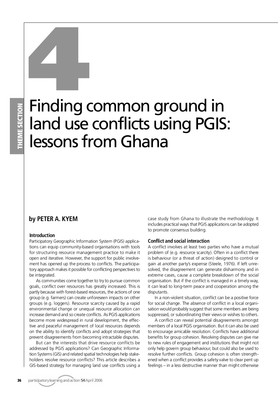Finding a common ground in multi-party land use conflicts using PGIS: lessons from Ghana (PLA 54)

Peter Kyem explores the role of PGIS in mediation and how the technology can be used to promote consensus building. Using the example of Kofiase in Southern Ghana, he identifies how PGIS applications helped conflicting stakeholders find a pathway to compromise and overcome heir disagreements.
As the practices associated with PGIS innovate and evolve, it is interesting to see examples of how specific tools are being modified and employed to address the issues faced by local communities – and to understand whether they are being useful and/or successful in helping to achieve their objectives.
Participatory Learning and Action (PLA, formerly PLA Notes) is the world's leading series on participatory learning and action approaches and methods. PLA publishes articles on participation aimed at practitioners, researchers, academics and activists. All articles are peer-reviewed by an international editorial board. See: www.planotes.org
Article in: PLA 54. Guest-edited by: Giacomo Rambaldi, Jon Corbett, Michael K. McCall, Rachel Olson, Julius Muchemi, Peter Kwaku Kyem, Daniel Wiener, Robert Chambers
Cite this publication
Available at https://www.iied.org/g02947